You don’t need a reservation to camp in the back country of Ocala National Forest, you won’t see a fire ring or a picnic table, and you may be camping in a spot where no one has ever camped before.

Ocala National Forest sprawls across Central Florida, a vast sand-pine scrub forest harboring 600 lakes, rivers, and springs, many wrapped in glorious subtropical vegetation like an oasis in a dry scrub desert.
But the real appeal to this forest is miles and miles of trails with unlimited opportunities to camp along those trails.
In this article, backpacker Kyle Albinus tells us about his camping adventure deep in the woods, away from the crowds.
Editor’s Note: Military training, fire hazards, flooding and hunting may result in closures of some areas of the forest. Check before you go by calling 352-625-2520. You should also check the Forest Service Facebook page for updates.
Finding your special place in Ocala National Forest
A grid of forest roads slices Ocala National Forest into a checkerboard, designed for access by rangers but open to the public. Most are unpaved grades, some in better shape than others.
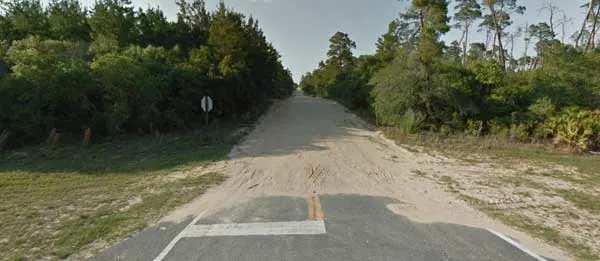
If you throw a dart at a map of the forest, you’ll also find a forest road that that will get you there.
An excellent resource is Delorme’s detailed Florida Atlas & Gazetteer, although you can find a useful interactive map on the forest’s web site.
On this adventure, I turned off State Road 40 onto Forest Road 65, which is less than a mile west of the Juniper Spring Recreation Area and Campground. Take note that Juniper Springs Run is an excellent 7-mile paddle trail for kayaks and canoes and is ranked among the best in the country.
Forest Road 65, like most of the forest’s service roads, is hard-pack sand. My Honda Civic was adequate, although I could hear sand scraping the bottom of the car from time to time. I imagine there are times you may need 4-wheel drive, but the unpaved roads were not especially rough.
About 3.5 miles north on Forest Road 65, you will come to a “T” where FR 76 meets 65, and that’s where I parked my car, at a marked trail entrance.
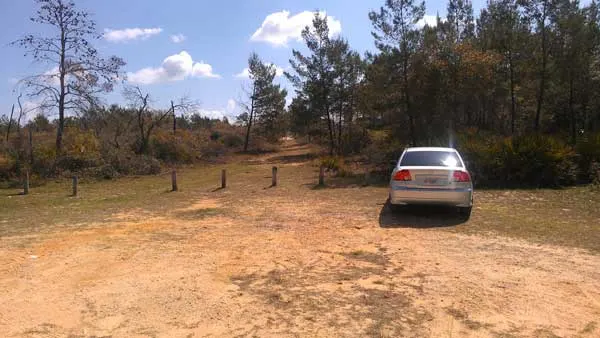
A nice sandy trail runs east from there and you will encounter numerous opportunities to stray from the trail and find a great camping spot. The more adventurous can follow any one of the smaller trails that criss-cross the area.
If you do stray off the main trails, you will want to have a GPS. What appears to be an easy trail to follow can fade quickly. I followed one trail that seemed obvious enough when I started, but it slowly disappeared as I followed it until it was nearly invisible. I was only able to recognize it because of depressions in the bushes.
A hand-held GPS unit, such as the Garmin eTrex, follow your tracks and allow you to mark waypoints so you can track back in the event you get lost.
Be prepared when dispersed camping
You have to carry everything with you — food, water, gear, everything. And you should never leave anything behind when you leave your site. Take it in, take it out.
The reward is peace and quiet, something you won’t get in a campground filled with Winnebagos.
The loudest noise you hear at night will be the wind rustling through the trees and a few coyotes. Maybe a bear stumbling around and, of course, songbirds in this migration haven.
Over the years, I have tried to balance weight against cost. I love camping, but I’m not going to buy a $400 tent to save one pound.
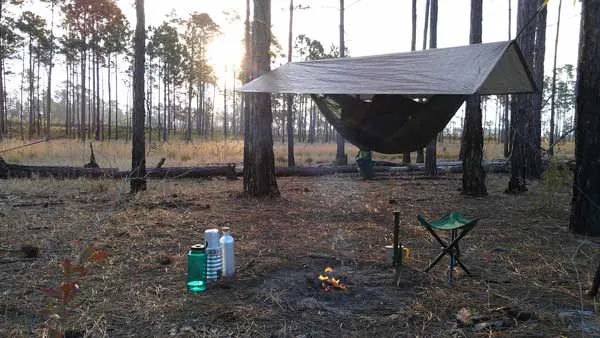
When camping alone, I have switched to a hammock tent, half the weight of a regular tent. I love it. Of course, the hammock sleeps just one, so when my wife joins me, we bring the tent.
My cooking gear is simple. An alcohol penny stove can be made from a couple of soda cans. A quick search on the internet will uncover about 100 different designs you can make, or you can buy a backpacking stove on Amazon for as little as $10.
I carry the alcohol for fuel in a flask. A Swiss canteen/cup/stove holder I bought for $10 makes up the rest of cooking gear, and a collapsible bowl and stainless steel cup complete my backpack “kitchen.”
I don’t take a lot of food and try to keep it simple. Either ready-to-eat foods or something to which I can just add boiling water. Good examples are Knorr side dishes, which serve as a full meal for one person. If the directions call for milk, bring powdered milk.
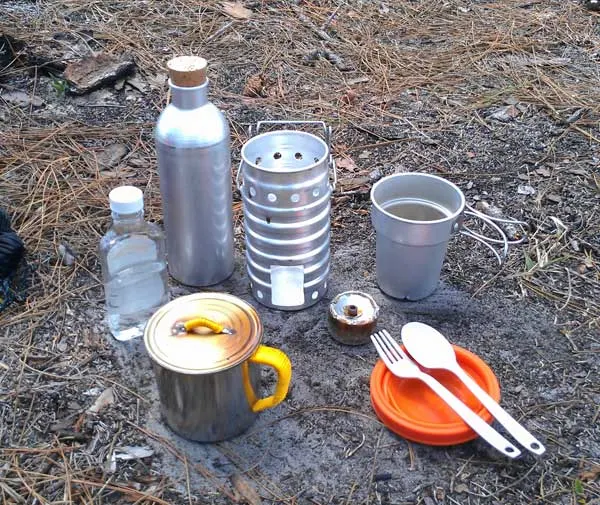
A trip to your local Asian food store will also give you a variety of choices. Instant noodle choices are endless, and I’m not just talking about Ramen. I found the best way to prepare noodles is to break them up in the package and pour them into my cup. Otherwise, I would need a larger bowl. Just add boiling water and wait a few minutes.
All manner of beef jerky products are available, and I sometimes break the jerky into smaller pieces and add to the noodles. By the time the noodles are ready, the jerky has softened nicely. You can also buy tuna in packets, and tuna on crackers in the afternoon is a great snack.
This is Bear Country! Bears roam freely in Ocala National Forest, and they are most active in fall. Secure food and food waste in bear-proof containers or suspend 10 feet above the ground. Read more about camping in bear country
If you are a coffee drinker, Asian markets also carry all-in-one coffee products with powdered milk, coffee and sugar in a single packet. Just add hot water.
I never was a Spam fan until I traveled to Japan. The Japanese developed an addiction to Spam, courtesy of American soldiers. I’ve had some incredible dishes based on this oft-scorned canned meat. You can also get it in foil pouches, and it is a great addition to rice while camping.
Water is a core requirement for your adventure. You need 1 to 2 liters of water per day, more if you are hiking a good distance on a hot day. On a recent three-day hike, I carried 6 liters of water, weighing about 13 pounds.
Bring a lightweight garden trowel to dig a hole away from camp for hygiene needs. About 8 inches deep should suffice. Use biodegradable toilet tissue, which you can or pack the tissue out with your trash.
If you are camping near one of the 60 lakes in the forest, a good filtration system will help you avoid some of that weight.
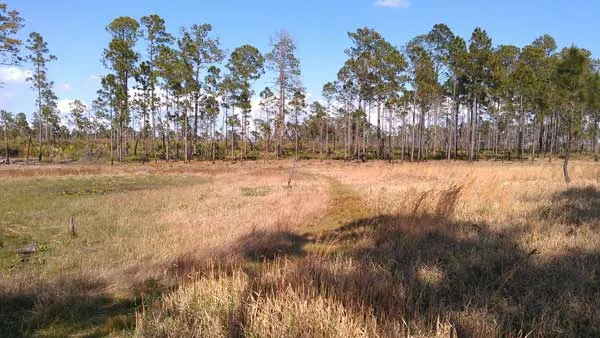
The forest can get quite dry in spring, and many small ponds or lakes run dry. If you look at the forest on Google Earth, the images may be old — what used to be a pond may now be just a grassy depression.
While you don’t need a permit to camp in Ocala National Forest, it is a good idea to check with forest rangers before you enter the forest to learn of areas under a fire watch. Call 352-625-2520.
A few thoughts about fire
Half the time I don’t build a campfire, opting to cook on my stove, though there is nothing quite like tending a campfire in the wilderness on a clear, star-filled night.
Be careful, though, especially during the dry season. One moment of carelessness could result in thousands of acres going up in smoke.
Brush away leaves and pine needles until you have a clear dirt area, then dig a shallow pit to contain the fire, and burn small pieces of wood. This allows it to burn out should you to leave the fire for a few minutes. Keep water close by to douse the fire if it gets out of hand.
The dry season in Ocala National Forest is October until May, which also happen to be the best months for camping, weatherwise.
When you leave, place your hand over the coals to detect warmth. The fire may be out, but the coals may still be going. Lastly, cover the pit with dirt so you don’t leave a mess for the next person.
There are some limits on dispersed camping
Dispersed camping is not allowed near developed recreation areas or less than 100 feet from streams and other water sources.
It’s best to choose a previously used site. Plants, soil and wildlife are impacted by new campsites.
Make your campsite less visible, so other visitors can experience a “wild” setting. Avoid camping in the middle of a clearing or meadow.
Be aware of forest boundaries, and seek permission before camping on private property.
Hunting: Hunting in the forest is regulated by the Florida Fish and Wildlife Commission. If you are hiking or camping in the backcountry during deer season, wear bright orange shirts or vests.
Designated areas for primitive camping
During hunting season, primitive camping is allowed only in designated camping areas, such as the developed recreation areas and these camping areas designated for primitive camping:
Looking for a campground with amenities? There are 15 developed campgrounds with picnic tables, fire rings & restrooms in Ocala National Forest, including two first-class state parks at its edges.
Resources and Links
Ocala National Forest Home Page
Visitor Centers: Note that visitor centers are temporarily closed to the public because of COVID-19. But you can call. (Oct. 2020)
- Pittman Visitor Center, 45621 State Road 19, Altoona, FL 32702. (352) 669-7495
- Lake George Ranger District, 17147 E. State Road 40, Silver Springs, FL, 34488. 352-625-2520
- Seminole Ranger District, 40929 State Road 19, Umatilla, FL 32784. 352-669-3153
Read This!!! Camping with Bears
Ocala National Forest – Wikipedia
The Florida Trail through Ocala National Forest
Related articles on Florida Rambler
Ocklawaha River: Kayak or canoe a river that was saved
6 things to do in Ocala National Forest
Marjorie Kinnan Rawlings’ Cross Creek
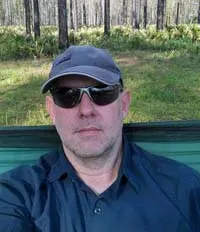
Kyle Albinus is a mechanical engineer based in Tampa who specializes in overseas manufacturing, But when he’s home, Kyle likes to backpack into Florida’s wilderness, far from RVs and people. You can visit his web site at mydesign1.com

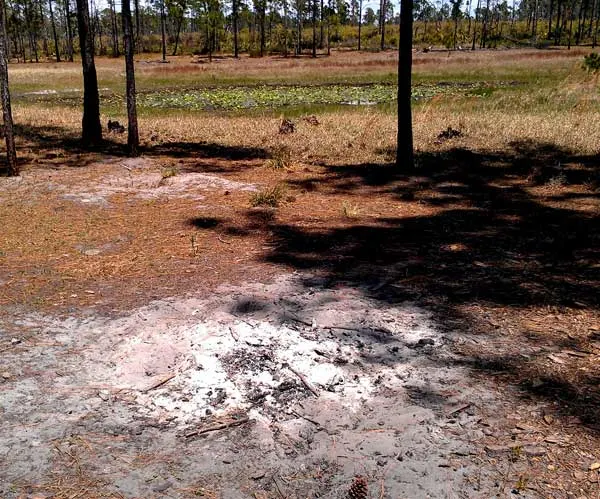
J Tollberg
Wednesday 22nd of February 2023
Wanted to thank you for this great guide! It was hard to tell the best spot to put in for camping/backpacking in Ocala National Forest, and this helped out immensely in planning ahead for the hike. My family and I had a great time and the stretch of trail was perfect...
I'll be sure to check out some of your other recommendations around the state. Thank you again!
Susie Elkins
Tuesday 26th of July 2022
Are car and van campers welcome? I am a senior citizen and no longer feel safe in a tent. Thank you. Susie
Bob Rountree
Wednesday 27th of July 2022
Hi Susie, the dispersed campsites described in this article are hike-in. Car and van campers are permitted in the forest's undeveloped campgrounds, but security would still be an issue unless you are with a group. (Safety in numbers.) Only developed campgrounds in Juniper Springs, Salt Springs, Alexander Springs and Clearwater Lake are monitored by rangers. Check out this story: floridarambler.com/florida-camping/ocala-national-forest-campgrounds/